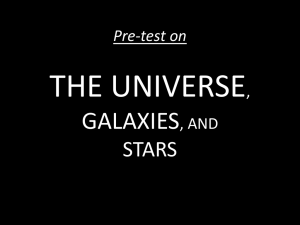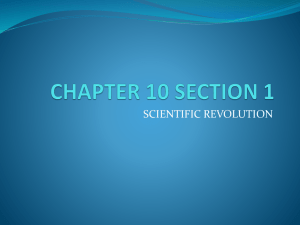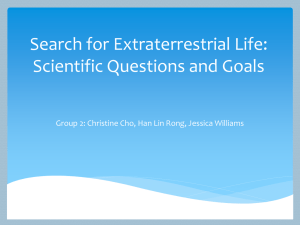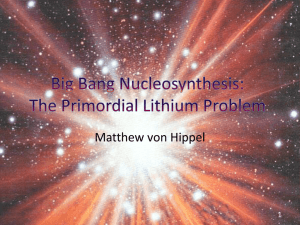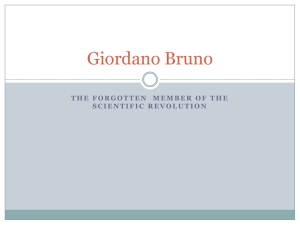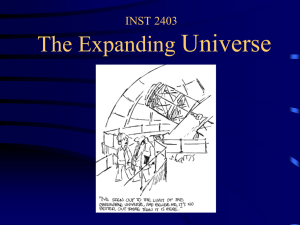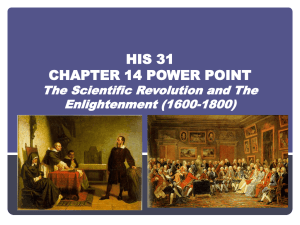Lecture12
advertisement
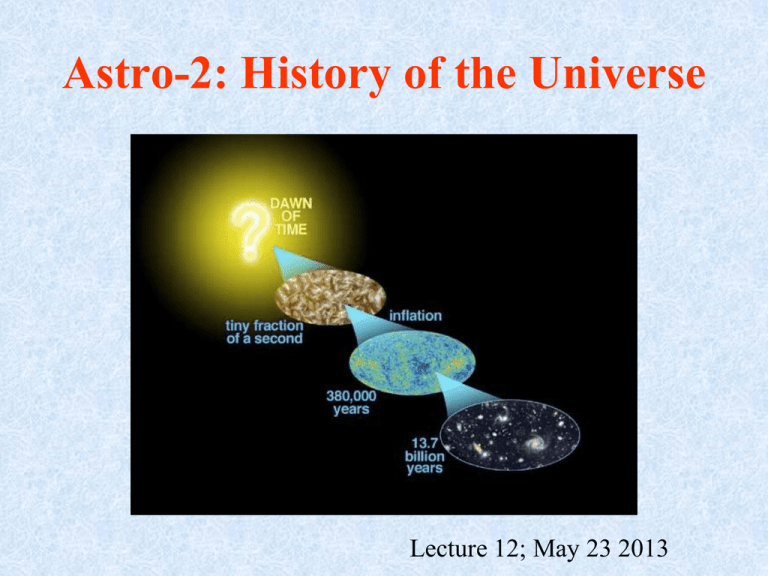
Astro-2: History of the Universe Lecture 12; May 23 2013 Previously… on astro-2 • • • • • • The four fundamental interactions are? Strong, weak, electromagnetic and gravity. We think they are unified at high energies, like those in the very early universe Before Planck time (which is?) energies were so high that a unified theory of all forces (including gravity) is required but we do not know how to do that. So our description can only begin from Planck time After that, as the universe expanded “cooled” the various forces froze out via spontaneous symmetry breaking Previously… on astro-2 • • • • • • • In the last twenty year the classic Big Bang model has evolved to include a period of inflation During inflation, as a result of a phase transition of a field called inflaton, space expanded dramatically so that our entire horizon was once in causal connection Did anything move faster than light? Is this violating some fundamental law of physics? NO! Inflation gives a “natural” explanation for fundamental questions such as the horizon problem Inflation predicts that space is flat, in agreement with observations Other observable properties (at least in theory!) of inflationary models are polarization of the CMB and fossil gravitational waves. See for more details, e.g.: http://background.uchicago.edu/~whu/polar/webversion/polar.html Today.. On Astro-2. 1. What’s the matter? 1. 2. 3. 4. Mass and energy conversion Heisenberg’s uncertainty principle Matter antimatter - Particle pair creation Symmetry violation. Matter rules. 2. Big Bang nucleosynthesis Mass and energy conversion • • • • • What does E=mc2 mean? Energy and mass are the same thing. If you take two particles, you accelerate them to amazing energies and throw them against each other you create articles with rest mass much larger than that of the initial particles. This is observed in particle accelerators You’ve converted kinetic energy into mass. A nuclear bomb (or the sun) do the inverse process Pair creation and annhilation • • When converting energy to mass certain properties (e.g. electric charge) have to be preserved For each particle there is an antiparticle with the same mass and opposite charge Pair creation Through series of these processes you can also change the type of particles, as long as conservation laws are not violated Heisenberg’s uncertainty principle • • • • • What does it mean? It does not mean that science is not precise or cannot decide It just means that some quantities cannot be determined simultaneously with infinite precision. For example the uncertainty on position and momentum (~speed) is larger than ΔxΔp=h/2π Heisenberg’s uncertainty principle • • • Similarly for Energy and Time ΔEΔt=h/2π Which means that for a very small amount of time you are allowed to “violate” energy conservation Heisenberg’s uncertainty principle • How long is the timescale? ΔEΔt=h/2π ΔE=Δm c2 Dividing the two: • • • – • • Δt=h/ (2π Δm c2) For an electron positron pair of mass 9.1 10-31 Kg each, you get: Δt=6.44 10-22 s Heisenberg’s principle and virtual pairs Pair production can happen out of nothing! Virtual pairs during inflation The time of inflation is much shorter than that of virtual pairs!!!! Virtual pairs become real pairs. Energy supplied by the decay of the inflaton! The universe is now filled with energy and particles A primordial high energy soup… • • Right after inflation the universe is so hot (1015 K) that annihilation and pair production were in equilibrium The universe was a hot soup of photons/bosons and particles switching back and forth The soup cools down… • • • As the universe expands the soup cools down… photons loose energy and fall below threshold to form particles At this point you cannot form any more pairs although particle pairs can still annhilate to form photons The net effect is that photons gain energy at the expense of matter and antimatter. And we have a problem! • • What happens if we now have only one process left because photons are too weak? We would have no particles left!! Only CMB!!! No us!!! Grand Unified theories save us! • • • Grand unified theories predict that some process violate conservation of baryonic number. From pair production you expect the same exact number of baryons and antibaryons (e.g. proton and antiproton) Very rarely, some interaction prefers matter, leaving an asymmetry behind. Observational and experimental evidence • • • • • We do not observe high energy gamma rays that we would expect if the universe was undergoing lots of annihilations! We know there is matter everywhere, so there can’t be any antimatter, otherwise we would see annihilation! There a billion photons per baryon in the universe so baryonic number is not conserved once for every billion interactions. If baryonic number is not conserved we expect the proton to be unstable over a long timescale and decay into a less massive lepton. Experiments say that the lifetime of the proton is at least 1032 s... so nothing to worry about! What’s the matter. Summary. • • • • • Energy and mass are equivalent through Einstein’s equation and can be converted into each other (pair production and annihilations) What is the meaning of Heisenberg’s principle During inflation matter (and antimatter) is created using energy from the inflaton field. As the universe cools down matter freezes out because photons are not energetic enough to do pair production Some interactions are slightly asymmetric, do not conserve baryonic number, and produce more matter than antimatter, resulting in the current matter dominated universe. Primordial nucleosynthesis • • As the universe kept cooling and no more protons anti protons were created weak interactions started to be important This created a balance of neutrons and protons abundance (about 1/6) at the time when electron positron pair production stopped (T~10,000,000,000 K) and e- became much less abundant Primordial nucleosynthesis • • • Normally, n are unstable particles, they decay in about 11 minutes However, there is also lots of protons around and beta decays have to compete with strong forces Strong forces like to bind n and p to form nuclei Primordial nucleosynthesis About a minute after Big Bang, photons were too weak to destroy the first nuclei, and p and n started to combine to form deuterium Primordial nucleosynthesis • D is very fragile so it doesn’t survive in the intense radiation field of the early universe • You have to wait until ~3 minutes that the universe gets cold enough so that D can survive and start to form Tritium and Helium Primordial nucleosynthesis In the next few minutes He and traces of Be and Li are formed Primordial nucleosynthesis • Knowing the interaction strength of the various processes from nuclear physics it is easy to compute what the distribution of early elements should be • This depends on the mass density of baryons • So the abundance ratios of primordial elements are a measure of the mass density in baryons • Proof that dark matter is non-baryonic!! Primordial nucleosynthesis • One complication is that stars change abundance ratios. For example: • Sun? • H->He • However, D is only destroyed in stars not form, so… • How can we measure primordial D abundance? What about the other elements? • All elements heavier than Li are produced in? • Stars • How are they dispersed in the environment and accumulated? Nucleosynthesis. Summary • • • • • • • • • As the universe cooled, it left behind a certain number of neutrons and protons (1/6) as a result of weak interactions Neutrons are unstable. Lifetime? 11 minutes They interact strongly with protons to form stable systems. Called? Nuclei During the first few minutes the universe was hot and dense enough that it produced elements up to Li. After that it was too cold. What does that mean? The measured abundance ratio is a measure of baryonic mass density. What does it prove? Where are all the other elements formed? The End See you on Tuesday!


